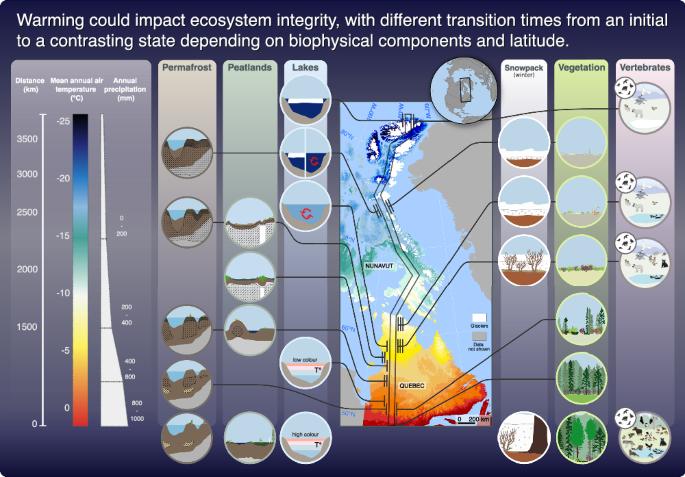专家对整个北方生态系统的状态转变和对气候变暖的不同敏感性的启发
IF 8.1
1区 地球科学
Q1 ENVIRONMENTAL SCIENCES
引用次数: 0
摘要
北部地区的变暖速度快于全球其他地区。由于生物物理成分的热敏感性各不相同,因此很难预测生态系统对气候变暖的反应。在此,我们介绍了作者对从北方到极地生物群落的六种生态系统成分--永冻土、泥炭地、湖泊、积雪、植被和内热脊椎动物--的敏感性的专家判断分析。我们在北美洲东北部 3700 公里的纬度梯度上确定了 28 种不连续的成分状态,并将敏感性量化为年平均气温理论阶跃上升 5 ℃ 后从初始状态到对比状态的过渡时间。我们推断,在一个狭窄的亚北极纬度带内,可能会发生多个相互关联的状态转变,时间尺度从 10 年到 100 多年不等,响应时间随纬度的增加而缩短。不同成分和不同纬度的响应时间不同,这可能会损害生态系统的完整性。根据对北方地貌敏感性的专家评估,气候变暖引起的永久冻土、泥炭地、湖泊、积雪、植被和脊椎动物的变化可能会影响北方生态系统的完整性,不同成分和不同纬度的反应时间不同。本文章由计算机程序翻译,如有差异,请以英文原文为准。

Expert elicitation of state shifts and divergent sensitivities to climate warming across northern ecosystems
Northern regions are warming faster than the rest of the globe. It is difficult to predict ecosystem responses to warming because the thermal sensitivity of their biophysical components varies. Here, we present an analysis of the authors’ expert judgment regarding the sensitivity of six ecosystem components – permafrost, peatlands, lakes, snowpack, vegetation, and endothermic vertebrates – across northern landscapes ranging from boreal to polar biomes. We identified 28 discontinuous component states across a 3700 km latitudinal gradient in northeastern North America and quantified sensitivity as the transition time from an initial to a contrasting state following a theoretical step change increase in mean annual air temperature of 5 °C. We infer that multiple interconnected state shifts are likely to occur within a narrow subarctic latitudinal band at timescales of 10 to more than 100 years, and response times decrease with latitude. Response times differ between components and across latitudes, which is likely to impair the integrity of ecosystems. Warming-induced changes in permafrost, peatlands, lakes, snowpack, vegetation, and vertebrates could impact northern ecosystem integrity, with different response times across components and latitude, according to an expert assessment of sensitivity in northern landscapes.
求助全文
通过发布文献求助,成功后即可免费获取论文全文。
去求助
来源期刊

Communications Earth & Environment
Earth and Planetary Sciences-General Earth and Planetary Sciences
CiteScore
8.60
自引率
2.50%
发文量
269
审稿时长
26 weeks
期刊介绍:
Communications Earth & Environment is an open access journal from Nature Portfolio publishing high-quality research, reviews and commentary in all areas of the Earth, environmental and planetary sciences. Research papers published by the journal represent significant advances that bring new insight to a specialized area in Earth science, planetary science or environmental science.
Communications Earth & Environment has a 2-year impact factor of 7.9 (2022 Journal Citation Reports®). Articles published in the journal in 2022 were downloaded 1,412,858 times. Median time from submission to the first editorial decision is 8 days.
 求助内容:
求助内容: 应助结果提醒方式:
应助结果提醒方式:


